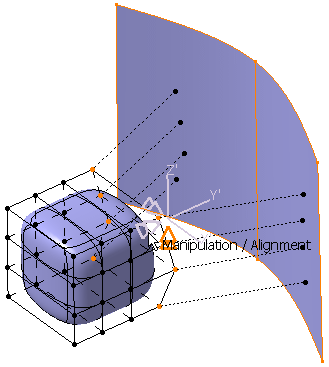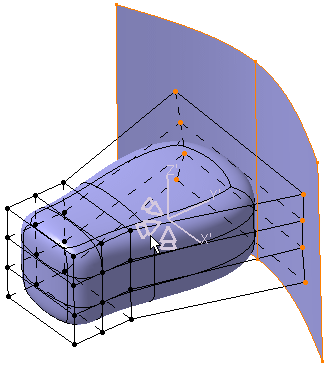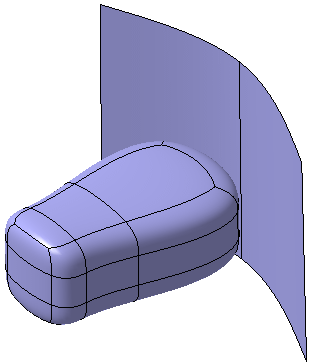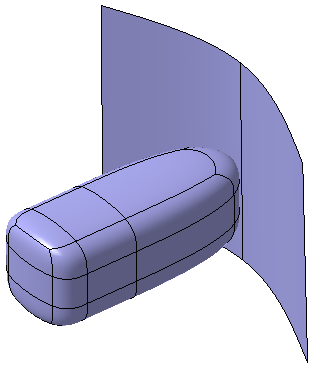-
Click Modification
 and select the surface.
and select the surface.

You can also access this command by pressing SPACE. -
Click Alignment
 .
.
You can also access this command by pressing CTRL+SHIFT+Q. When the Alignment command is activated, five new icons appear in the Tools Palette:

The following icons let you: -
 project
vertices onto the axis of the compass.
project
vertices onto the axis of the compass.
-
 project
vertices onto the plane of the compass.
project
vertices onto the plane of the compass.
-
 pick
one or more 3D elements in the 3D area to define the projection support.
pick
one or more 3D elements in the 3D area to define the projection support.
The other icons let you filter the type of aligning feature: surface, edge or vertex. -
-
Click Compass Definition
 to define the compass' position as shown.
to define the compass' position as shown.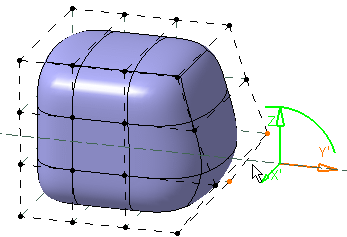
-
Click Compass Definition
 again.
again.
Projecting onto the Axis
-
Click On Axis
 .
.
When this option is activated the following options are available for surface selection: Edge Selection, Vertex Selection, All Elements Selection. -
Select elements to be projected.
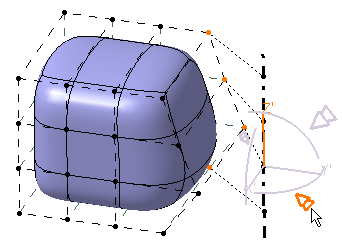
The manipulator arrows are displayed on each axis.
The manipulator is active when you are in the picking zone. You can click anywhere in the picking zone for modification.As you are in the picking area of the manipulator, the projection axis and traces of projections are viewed. This axis size is defined to include all the projected points. The interactive arrows' direction is normal to the plane (it indicates the direction of projection).
-
Click the manipulator arrow depending on the direction where you want to align the vertex.
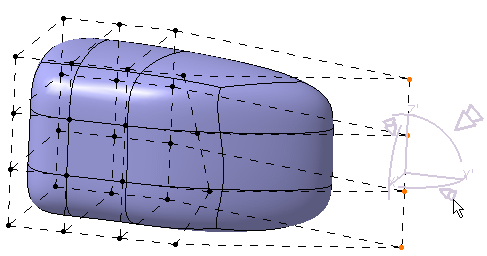
The selected elements are projected on the axis.

Projecting onto the Plane
-
Click On Plane
 .
.
When this option is activated the following options are available for surface selection: All Type Selection, Face Selection, Edge Selection, Vertex Selection, All Elements Selection. -
Select elements to be projected.

The manipulator arrows are displayed on each axis.
The manipulator is active when you are in the picking zone. You can click anywhere in the picking zone for modification.
As you are in the active manipulator zone, the projection plane and traces of projections are viewed. This plane size is defined to include all the projected points. The interactive arrows' direction is normal to the plane (it indicates the direction of projection). -
Click the interactive arrow depending on the direction where you want to align the vertex.
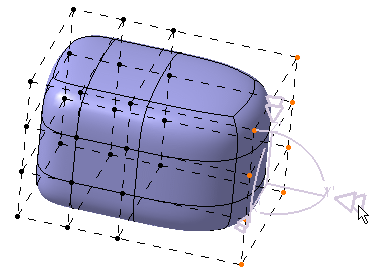
The selected elements are projected on the plane.
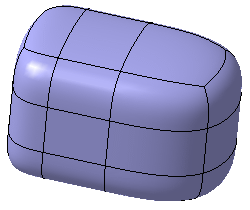
Aligning Vertices Orthogonally
Aligning Vertices Along a Direction
Using Pick
-
Click On Plane
 .
. -
Select the elements to be projected.
-
Click Pick
 .
. -
Select the projection plane as shown.

You can see that the projection of the selected element is made directly on this plane.
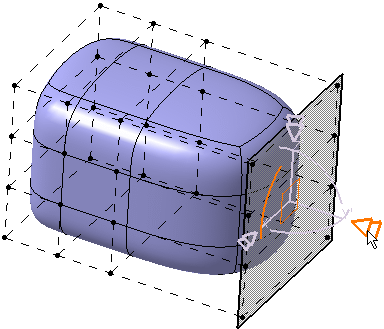
Here is the result: 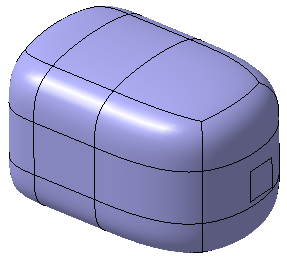
-
Click On Axis
 .
. -
Select the elements to be projected.
-
Click Pick
 .
. -
Select the projection line as shown below:
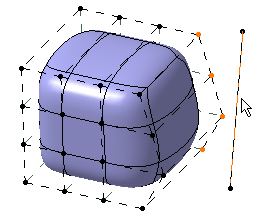
You can see that the projection of selected axis defined by the line is made directly after the line selection.

Here is the result: 

- In case you have clicked On Plane you can also pick a line to project on the plane.
- In case you have clicked On Axis you can also pick a plane to project on the axis.
- You can pick a line or plane to project on a point.
-
Ctrl and Shift keys are used for selection. When these keys are pressed, the manipulator is inactive even in the active manipulator zone.
-
In case of element selection, manipulators can be deactivated by keeping the Ctrl key pressed. This allows better selection of elements. To reactivate the manipulators, release the Ctrl key.
-
If no element is selected for the projection, the manipulator is inactive even in the active manipulator zone.
-
The manipulator's active picking zone is located between two virtual circles (red and yellow circles). Thus it is not possible to manipulate the manipulator near the axis (yellow circle) and outside the red circle.

-
The display of the projection plane depends on the option selected for transparency in Tools > Options > Display > Performance tab, Transparency Quality area. The options are:
-
Low (Screen Door)
-
High (Alpha Blending)
For more information on these options, see CATIA Infrastructure User's Guide: Customizing: Customizing settings: Performance.
-
-
The visualization of hidden elements depends on the state of View and Selection mode
 icon
in the Operations toolbar. For
more information, see Selecting
Visible Elements.
icon
in the Operations toolbar. For
more information, see Selecting
Visible Elements. -
It is not possible to project a face or an edge onto an orthogonal edge. An error message is displayed.
-
It is not possible to project two opposite edges of the same face onto a common axis. A similar error message is displayed.
![]()
